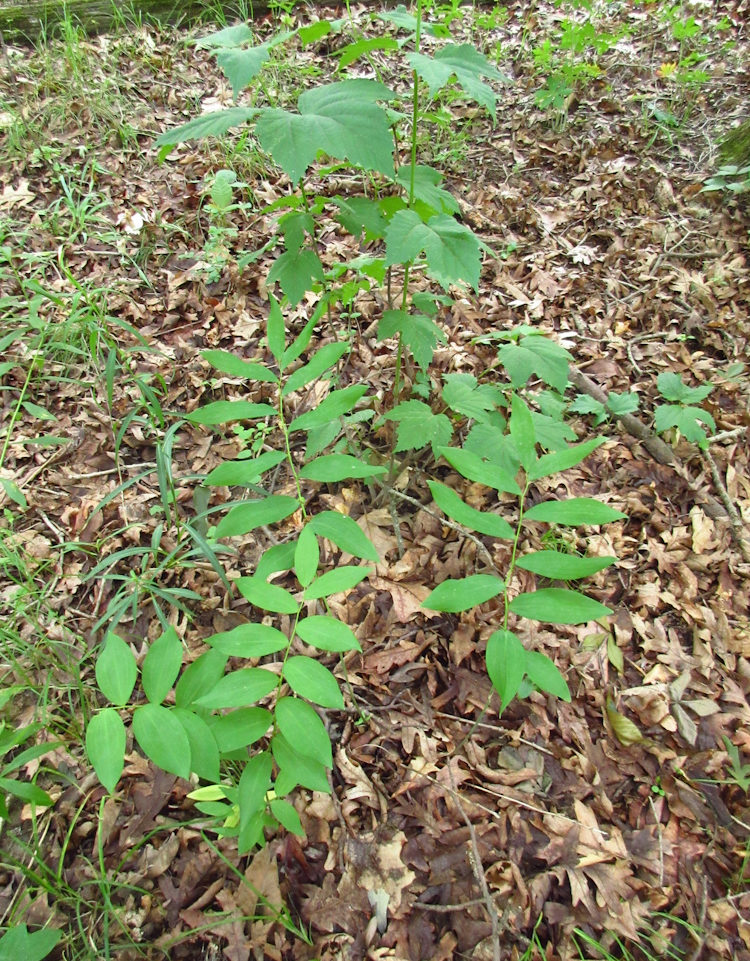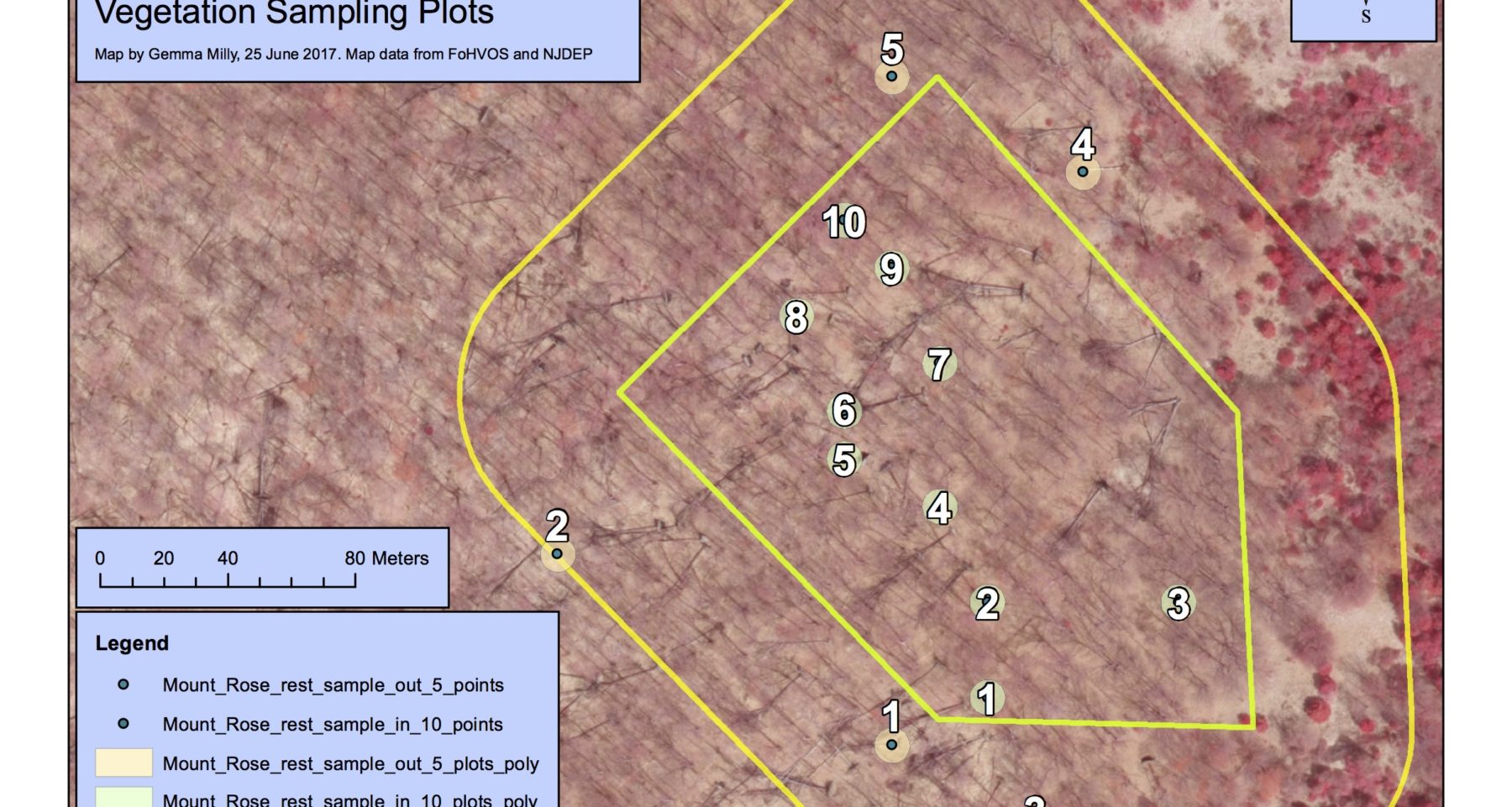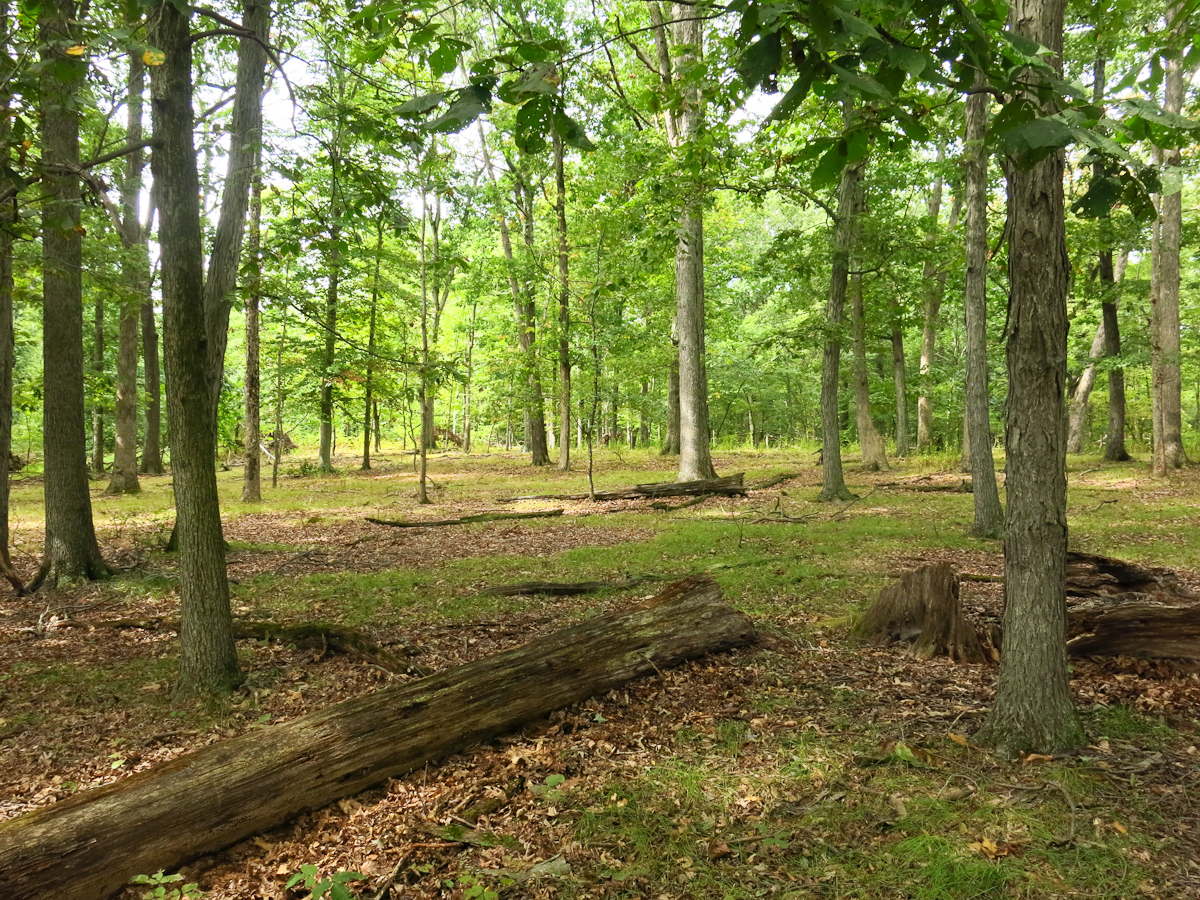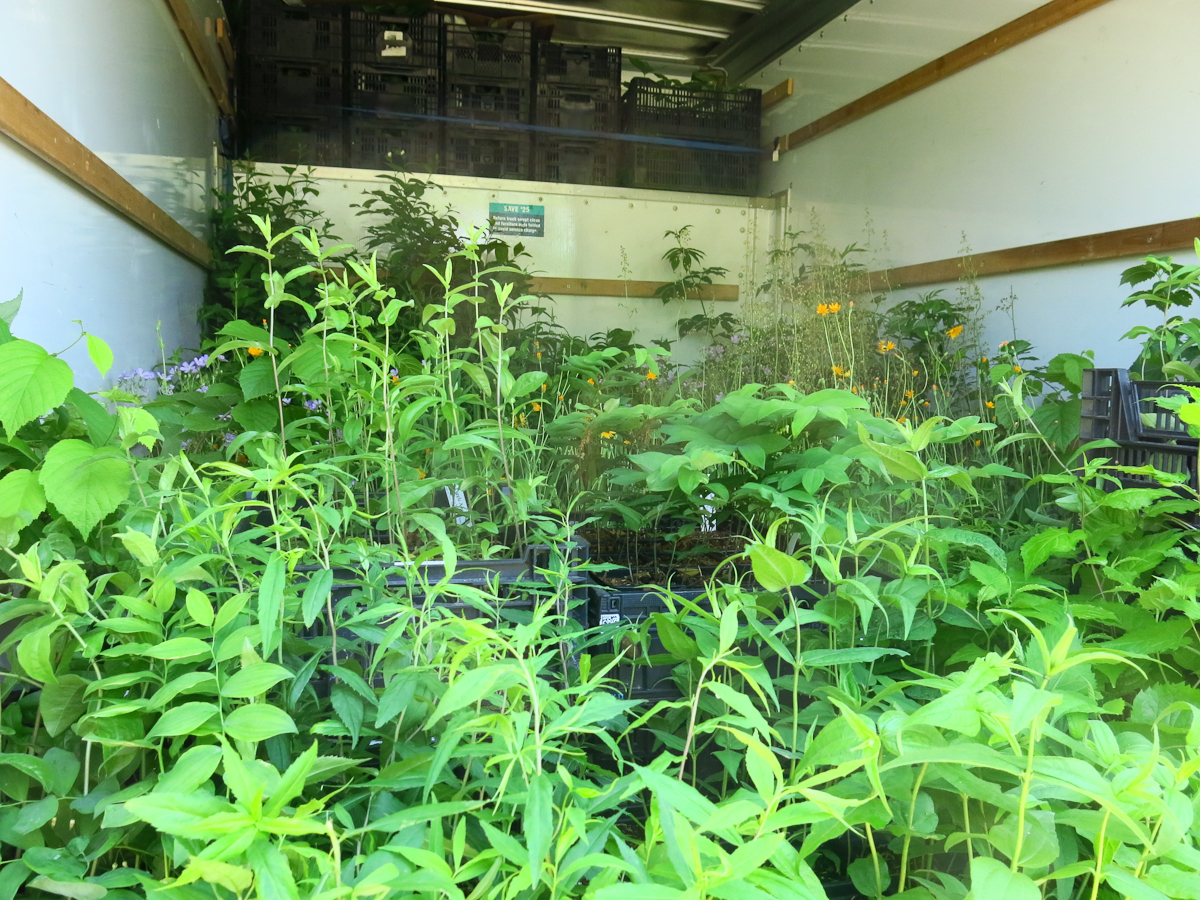Overview
The Mount Rose Preserve Forest Restoration Project is sited within an area of the Mount Rose Preserve in Hopewell, NJ, comprised of forests over a hundred years old but with a very limited forest understory due to deer overbrowse. The primary restoration goal is to re-establish a diverse, structurally complex understory such as found within the target reference ecosystem. A secondary goal is to innovate and communicate locally appropriate forest restoration practices. Additional goals include the natural recovery of existing plant species through the exclusion of white tailed deer and successful augmentation with native plant materials. Monitoring is prioritized, and goals are tied to the re-establishment of floristic quality appropriate to the site’s status as a mature forest.
The Mount Rose Preserve is a 397-acre preserve in the Piedmont province of central New Jersey, comprised of forest, shrubland, and meadow habitats. This Project is a component of the overall stewardship plan for the preserve, developed by the Friends of Hopewell Valley Open Space.
Project objectives for 2016-2017 included: baseline monitoring, selection of a site for 5-acre experimental deer fence, installation of deer fence, inventory of fenced and control botanical survey plots, selection of planting locations, and delivery and planting of native plant materials.
Quick Facts
Project Location:
Mount Rose Preserve, New Jersey, USA, 40.361478, -74.73760670000001
Geographic Region:
North America
Country or Territory:
United States of America
Biome:
Temperate Forest
Ecosystem:
Temperate Forest - Deciduous
Project Lead:
Wild Ridge Plants, LLC
Organization Type:
Consultant / Consulting Company
Project Partners:
Friends of Hopewell Valley Open Space
New Jersey Conservation Foundation
Location
Project Stage:
Monitoring & Evaluation
Start Date:
2016-10
End Date:
2022-10
Primary Causes of Degradation
Agriculture & Livestock, Deforestation, Fragmentation, Invasive Species (native or non-native pests, pathogens or plants), OtherDegradation Description
Historic land use impacts (grazing), and the impact of overbrowse by white-tailed deer have contributed to a depauperate understory lacking in native herbaceous plants and tree regeneration.
Defining the Reference Ecosystem
The reference ecosystem is primarily based on contemporary reference sites or existing analogues of the pre-degradation ecosystem.Reference Ecosystem Description
The restoration area is characterized three distinct forest types. The area is predominantly dry oak woodland in shallow soils over Passaic formation red shale bedrock and regolith. A smaller portion is comprised of wetlands dominated by pin oak, and an even smaller portion is a mesic lowland forest characterized by beech.
I used the open oak woodland community at St. Michaels Preserve (approximately two miles away) as the primary reference site for the dry oak woodland at Mount Rose Preserve. I conducted botanical surveys at the St. Michaels Preserve in 2010. Other nearby areas of open oak and hickory woodlands included those at Mercer County Park, and small fragments in the Sourland Mountains. Farther afield, areas of open dry glades at Pyramid Mountain and other sites in the New Jersey Highlands were considered. These are in a separate geological province, but geographically fairly close to the site. These latter sites were chosen because they inform some of the structural aspects of understory for the project; they have less severe deer browse impacts. The nearby sites suffer from similar levels of deer browse and are usually somewhat deficient in structure and species density. Together, these sites comprise the reference ecosystem.
Monitoring using floristic quality assessment and a plot-based methodology determined that all plots within the deer exclosure meet an FQA (floristic quality assessment) threshold for “Moderate Quality Natural Area”. Our restoration objective is for the majority of those plots to indicate a “High Quality Natural Area” by 2022. We use this metric, rather than percent cover of different understory strata, because we feel it allows for site heterogeneity and emphasizes quality rather than a rigid quantitative measure.
Project Goals
Our goal is to restore this to a High Quality area as ranked by floristic quality assessment, as suggested by the maturity of the forest and the quality of the tree canopy. This will depend on diversification of the herbaceous and woody understory layers. Socio-economic goals are to model the practice of forest understory restoration for the region. Our long-term target for the restoration site is full recovery (as defined in the SER International Standards, p. 9).
Monitoring
Monitoring Details:
Ten randomly placed plots inside the deer exclusion fence, and five control plots outside the fence were surveyed May 15 2017. Each plot is 100m2 and circular in shape. See attached map for plot locations. Plots to be resurveyed at interval (three or five years) hence. Plots were permanently marked with rebar painted orange, and are recorded in Friends of Hopewell Valley Open Space' GIS. Survey results were calculated using Floristic Quality Assessment.
Start date, including baseline data collection:
May 15 2017
End Date:
May 15 2022
Stakeholders
The Mount Rose Forest Restoration Project is a component of the overall stewardship plan for the preserve written and administered by the Friends of Hopewell Valley Open Space (FoHVOS). The plan is based on stakeholder interviews (in keeping with “early, genuine and active engagement with all stakeholders” SER International Standards p. 23) as well as baseline field investigation and GIS analysis. Primary restoration targets of the plan are forest, shrubland, and meadow habitats requiring a cessation of threats including overbrowse by white-tailed deer and the proliferation of invasive plant species. The establishment of appropriate recreational trails is also a significant priority related to stakeholder engagement and long-term viability of the preserve in the community.
How this project eliminated existing threats to the ecosystem:
Deer fencing, invasive species removal
How this project reinstated appropriate physical conditions (e.g. hydrology, substrate)",:
none
How this project achieved a desirable species composition:
We chose forty-four native species to augment the depauperate native understory in the restoration site. We propagated these species in our nursery. Each species originated from genetically diverse seed we collected in New Jersey, in keeping with current guidelines for appropriate restoration plant materials.
We delivered over 1,000 plants for Spring 2017 and the remaining 1,010 plants will be delivered Fall 2017. The species include: Actaea racemosa, Allium tricoccum, Amelanchier arborea, Aralia racemosa, Arisaema triphyllum, Bromus pubescens, Carex argyrantha, Carex swanii, Carpinus caroliniana, Collinsonia canadensis, Corylus americana, Cunila origanoides, Elymus hystrix, Euonymus americanus, Eupatorium perfoliatum, Eurybia divaricata, Eurybia macrophylla, Eutrochium purpureum, Fragaria virginiana, Geranium maculatum, Hamamelis virginiana, Helianthus divaricatus, Helianthus strumosus, Heuchera americana, Hydrophyllum virginianum, Iris versicolor, Krigia biflora, Laportea canadensis, Lilium superbum, Lindera benzoin, Lobelia cardinalis, Lobelia siphilitica, Maianthemum racemosum, Packera aurea, Polygonatum pubescens, Pycnanthemum incanum, Rosa virginiana, Sambucus canadensis, Scutellaria lateriflora, Solidago caesia, Symphyotrichum cordifolium, Symphyotrichum patens, Thalictrum thalictroides, and Viburnum acerifolium.
How this project reinstated structural diversity (e.g. strata, faunal food webs, spatial habitat diversity):
Both deer fencing and augmentation plantings will increase diversity in the understory strata and support a variety of fauna, from pollinators to bird and small mammal species
How this project recovered ecosystem functionality (e.g. nutrient cycling, plant-animal interactions, normal stressors):
See plantings, above
Activities were undertaken to address any socio-economic aspects of the project:
The socio-economic aspects are part of the larger preserve scope and administered by Friends of Hopewell Valley Open Space. They primarily involve stakeholder input, and a nearby bicycle trail.
Ecological Outcomes Achieved
Eliminate existing threats to the ecosystem:
FoHVOS land stewards have been removing woody invasive species from the project area. I don't have current data on the extent and effectiveness of their work.
Achieve a desirable species composition:
Survivorship among planted species has been excellent, and existing native species are beginning to respond to deer exclusion. Follow-up monitoring with quantitative data has not yet been done.
Factors limiting recovery of the ecosystem:
Existing native understory plants have responded to deer exclusion positively, according to visual observations. Follow-up monitoring with quantitative data has not yet been done.
Socio-Economic & Community Outcomes Achieved
Long-Term Management
The property is preserved and is managed by the Friends of Hopewell Valley Open Space, a group with a strong commitment to land stewardship
Primary Contact
Name:
Jared Rosenbaum, CERP
Affiliation:
Wild Ridge Plants, LLC
City:
Pohatcong
State:
NJ





